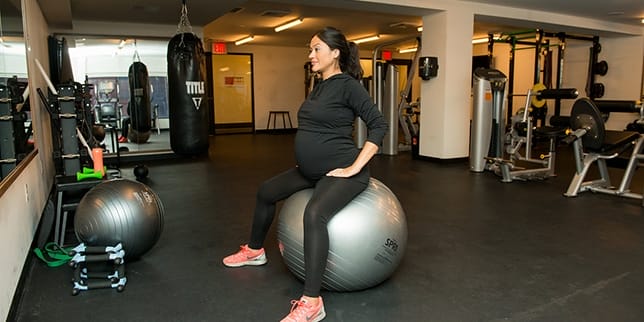Postpartum exercise guidelines are changing–here’s why some OBGYNs recommend waiting 12 weeks after birth to workout

Pixel-Shot/Shutterstock
It’s all about protecting your pelvic floor.
Table of Contents
If you’ve recently been pregnant, you may be wondering: when is it OK to work out again?
Many women can’t wait to start exercising again after pregnancy. For others, sweet baby snuggles tend to win out over exercising for the first few weeks. Once you catch up on sleep and start to gain more energy, you may be ready to do Pilates or go for a jog again—but it might not be safe to jump back in with the same intensity level in your postpartum exercise as in your pre-pregnancy routines.
When my kids were babies, working out was the last thing on my mind. I was too busy figuring out how to breastfeed and trying to catch up on sleep as best I could. At my six-week postpartum checkup after my first two sons were born, I was cleared to work out right away and excited to get started. But when I had my third baby earlier this year, my OBGYN asked me to wait until I was 12 weeks postpartum to do any moderate- to high-intensity exercising.
My doctor recommended walking, swimming and stretching immediately, but holding off on any other workouts until my baby was 3 months old because it was safer for my pelvic floor recovery.
I was so confused. The same doctor had cleared me to exercise at six weeks postpartum two previous times—with no other instructions. Not to mention, friends who had babies around the same time as my third were cleared by their doctors at six weeks. So why was I getting a different recommendation?
It turns out, new research backs waiting until 12 weeks postpartum to do high-intensity workouts, and many OBGYNs have adjusted their postpartum exercise recommendations acccordingly.
Ease back into exercise before 12 weeks
Women who’ve had a healthy pregnancy and a normal vaginal delivery should be able to start doing light exercises a few days after giving birth—or when you feel ready—according to the American College of Obstetricians and Gynecologists (ACOG) and March of Dimes. The organizations both recommend asking your OBGYN before you start exercising, especially if you had a cesarean birth or complications.
“Many women can safely begin light exercise shortly after giving birth and for the first 4 to 6 weeks postpartum,” Heather Jeffcoat, DPT, pelvic health physical therapist, founder of Fusion Wellness & Femina Physical Therapy, President of the Academy of Pelvic Health Physical Therapy, and Poise partner, tells Motherly.
When you do start working out, ACOG suggests easing back into it. Aim to stay active for 20 to 30 minutes a day, starting with simple exercises that strengthen abdominal and back muscles, then slowly adding in moderate-intensity exercises and working your way up to higher-intensity workouts.
Related: 5 expert tips for healing your pelvic floor from birth (without leaving home)
“Start with core exercises that incorporate your pelvic floor, and gradually increase impact,” Dr. Jeffcoat explains. “Start with walking before you jog, and jog before you run. Stop whatever you’re doing and see a pelvic health physical therapist if you experience any leakage, signs of prolapse (pelvic heaviness or pressure), back or joint pain.”
Working out is important for your postpartum recovery. ACOG says exercise in the postpartum period helps strengthen abdominal muscles, boosts energy, may prevent postpartum depression, promotes better sleep, relieves stress, and can help you lose extra weight you may have gained during pregnancy.
Additionally, pelvic floor strength is important in new moms.
“Having suitable midline and pelvic floor support is essential for daily functional activities, including many of the new ones involving your little bundle of joy,” adds Dr. Jeffcoat. “To build up strength and endurance in this area, try doing some new, simple activities like lifting your baby or your stroller while contracting your pelvic floor and drawing your belly button towards your spine—regular repetition of these common movements will go a long way in helping restore your strength postpartum.”
Wait to do high-intensity exercises until 12 to 16 weeks postpartum
While light exercises are OK, women shouldn’t jump back into high-intensity exercises until at least 12 weeks postpartum.
The Association of Chartered Physiotherapists in Sports and Exercise Medicine endorsed updated postpartum exercise guidelines in 2019, which recommends that most people who’ve given birth should wait to do high-impact exercises like running until 3 to 6 months postpartum, at the earliest. This can reduce the risk of health conditions like hernias, muscle tears, falls, urinary incontinence, and pelvic organ prolapse.
“We therefore recommend that a low impact exercise timeline is followed within the first 3 months of the postnatal period,” state the study authors.
Dr. Jeffcoat says, “Most women should not do anything strenuous [like running] for at least 12 weeks after delivery. And if you experience any signs of pelvic floor dysfunction, such as incontinence or pelvic pressure, then running is off the table until you can be evaluated.”
A 2021 study found high-intensity and/or heavy load training exercises (like lifting weights) should be avoided until at least four months postpartum because “deterioration of abdominal muscle function has been noticed in this period.”
“In general, women tend to return to intense exercise too soon, which can worsen pelvic floor dysfunction,” adds Dr. Jeffcoat.
Pregnancy increases your risk of pelvic floor dysfunction
It can be challenging to put off postpartum exercise when you are excited to start working out again, but it’s important to go slowly and trust your body to heal. Especially because pregnancy (and vaginal childbirth in particular) is strongly associated with pelvic floor disorders later in life.
Pelvic floor dysfunction (PFD) refers to a broad number of symptoms and anatomic changes related to your pelvic floor. This includes urinary incontinence, difficulty urinating, pain with intercourse, pelvic organ prolapse (when pelvic organs drop below their normal anatomic level), constipation, fecal incontinence, pelvic pain and more.
“Take time to allow your body to heal and understand some of the physical changes you may be experiencing,” says Dr. Jeffcoat. “Regardless of the mode of delivery, pregnancy in general (especially a first pregnancy) increases your risk of pelvic floor dysfunction.”
Related: Secrets to better postpartum care from mothers across the globe
The 2019 exercise guidelines referenced earlier also suggest postpartum women should be offered a pelvic health assessment with a specialized physiotherapist to assess the abdominal wall and pelvic floor. This is for the prevention and management of urinary incontinence, pelvic organ prolapse, improved sexual function, and pelvic floor dysfunction.
Even if you don’t see a physiotherapist, you can pay attention to your body’s needs as you begin a new workout routine.
The guidelines suggest running (or other high-impact exercises) should be discontinued if a woman experiences any of the following symptoms prior to, during, or immediately after the workout:
Warning signs of pelvic floor dysfunction:
- Heaviness/dragging in the pelvic area
- Leaking urine or inability to control bowel movements
- A noticeable gap along the midline of your abdominal wall
- Pelvic or lower back pain
- Ongoing or increased blood loss beyond 8 weeks postpartum that is not related to your menstrual cycle
“You should take things at your own pace and follow your doctor’s specific guidance,” says Dr. Jeffcoat. “Remember, whether you had a vaginal birth or cesarean delivery, your body nurtured a baby for about 40 weeks (stop for a moment to think about how beautiful that is!) and now must recover from that heroic effort. “
While it may be tempting to get back to your pre-baby fitness routine, it’s important to listen to your body and not overdo it. You could potentially hurt your recovery by working out too much, too soon, leading to pelvic floor issues down the line. Consult a doctor and/or a physiotherapist before starting a new postpartum workout plan to ensure you don’t hurt yourself!
Featured experts
Featured experts
Heather Jeffcoat, DPT, is a pelvic health physical therapist, founder of Fusion Wellness & Femina Physical Therapy, president of the Academy of Pelvic Health Physical Therapy, and Poise partner. She is the author of Sex Without Pain: A Self Treatment Guide to the Sex Life You Deserve, and she has lectured internationally on female sexual dysfunction and chronic pelvic pain.
Sources
Fukano M, Tsukahara Y, Takei S, Nose-Ogura S, Fujii T, Torii S. Recovery of Abdominal Muscle Thickness and Contractile Function in Women after Childbirth. Int J Environ Res Public Health. 2021 Feb 22;18(4):2130. doi:10.3390/ijerph18042130.
Goom T, Donnelly G, Brockwell E. Returning to running postnatal – guidelines for medical, health and fitness professionals managing this population. 2019. doi: 10.13140/RG.2.2.35256.90880/2.
Grimes WR, Stratton M. Pelvic Floor Dysfunction. Updated 2021 Nov 22. In: StatPearls [Internet]. Treasure Island (FL): StatPearls Publishing.
Hallock JL, Handa VL. The Epidemiology of Pelvic Floor Disorders and Childbirth: An Update. Obstet Gynecol Clin North Am. 2016 Mar;43(1):1-13. doi:10.1016/j.ogc.2015.10.008.







































